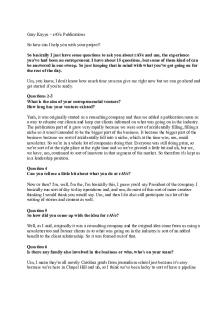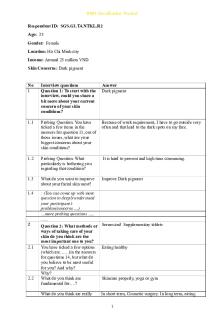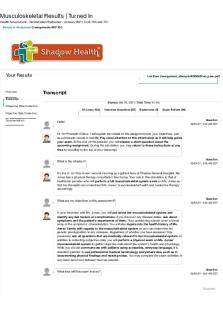Meeting academic expectations transcript PDF

| Title | Meeting academic expectations transcript |
|---|---|
| Author | Rahiq Raees |
| Course | Mathematics |
| Institution | York University |
| Pages | 3 |
| File Size | 79.8 KB |
| File Type | |
| Total Downloads | 4 |
| Total Views | 135 |
Summary
Lecture notes...
Description
Meeting academic expectations Slide 2 Starting university is an exciting event. By using the on-campus resources, planning ahead, and regularly checking your progress, you will increase your chances of succeeding. Here is some important information you need to know about the grading scheme, academic standing, and tips on making decisions about your courses.
Gr Grade ade adess Slide 3 Your university transcript with the list of courses you complete and the grades you receive could be found on ACORN. The transcript will also show your academic standing as well. Let’s look at the grading scheme at the University of Toronto.
Slide 4 It’s probably different from how you were graded in high school. You’ll notice that, in addition to letter grades and percentage marks, U of T uses Grade Point Averages known as the GPA system. The GPA value ranges from 0 to 4.0. You will receive both the letter and percentage grades on your transcript.
Slide 5 There are two different GPA types. Your Sessional GPA is the average grade point average of the courses you take in each semester. Your cumulative GPA is calculated by averaging all the courses with grades you completed at UofT. You can look up this information in the UTSC academic calendar.
Slide 6 One of the most commonly asked questions from students is this. After failing a course, if I re-take the course, will the second grade replace the failing grade? Unfortunately, the answer is no. This means that, if you take a failed course again, both grades will appear on your transcript and count toward your cumulative GPA.
Slide 7 This is why it’s important to pause and think about whether you should keep or drop your courses before the academic deadline. If you drop the course by the academic deadline, the course name will be removed from your transcript and it will not count towards your GPA.
Slide 8 To find out how you are being evaluated in the course, take a look at your syllabus. Try to calculate what kind of grade you need on the final or the rest of the assignments you need to hand in before the drop date. If you think you have a high chance of failing a course, it’s better to drop the course, so that the failing grade won’t affect your GPA.
Slide 9 Once you have an idea of the grades you are aiming for in your courses you could use the GPA calculator to estimate what GPA you might end up with. This is a great tool to use, especially if you are trying to get into a limited program or you are trying to maintain a certain GPA.
Ac Acade ade ademic mic stan standin din dingg Slide 10 Once you complete and receive your grades for at least 3.0 credits, the university will assess how you are doing academically. Most of the courses at UTSC are worth half a credit, so your status will be assessed when you complete 6, half-credit courses. If your Cumulative GPA is 1.6 or higher, you will be in good standing.
Slide 11 But, if your CGPA is below 1.6, you will be put on academic probation. Being on academic probation means that you will have to take fewer courses in the following semester and the university will follow-up with you to see how you are doing. If your grades continue to struggle academically, you may be suspended. Check out the information on the Registrar’s website to learn more.
Slide 12 If you are having academic difficulty, take a look at what types of challenges are affecting you. Whether you are having a tough time keeping up with your courses, feeling stressed, struggling with personal or financial challenges, there are resources to support you. You could also meet with an Academic & Learning Strategist to improve your study skills and find strategies to improve your academic standing.
Cr Cr/NCR /NCR & LWD Slide 13 Using credit, no credit, and late withdrawal options for your courses could help you to maintain a higher GPA. You can use Credit, no credit for 2.0 credits in electives and you can “try out” a course without risking your GPA since the grades will not count. To receive the credit, you must receive at least 50% in the course.
Slide 14 If you missed the academic drop deadline to remove the course from your transcript, you can also make a request for a late withdrawal on e-service, which is available on the Registrar’s website. You can do this for up to 3.0 credits during your entire degree. This is especially helpful when the course is not going as well as you expected. Refer to the Registrar’s guide for more information and make sure to check the deadlines. You can find the links to the resources mentioned in this video in the comment section below.
Resources mentioned in the video Academic standing: www.utsc.utoronto.ca/registrar/academic-standing Credit/No Credit courses: www.utsc.utoronto.ca/registrar/credit-no-credit-courses GPA calculator: www.rosi.utoronto.ca/gpa_calculator.php Grading scheme: utsc.calendar.utoronto.ca/7-understanding-marks-and-grades Late withdrawal from courses: www.utsc.utoronto.ca/registrar/dropping-courses Registrar’s guide (academic deadline): www.utsc.utoronto.ca/registrar/registrars-guide...
Similar Free PDFs

Expectations
- 2 Pages

Transcript
- 2 Pages

Great Expectations
- 82 Pages

Transcript 2
- 3 Pages

SGS transcript
- 3 Pages

Great Expectations
- 5 Pages

Interview transcript
- 7 Pages

N4685M1 transcript
- 7 Pages

Annotated-Meeting-Agenda
- 1 Pages

My Expectations for STS
- 1 Pages

Great expectations - Summary
- 83 Pages

Musculoskeletal Transcript
- 10 Pages
Popular Institutions
- Tinajero National High School - Annex
- Politeknik Caltex Riau
- Yokohama City University
- SGT University
- University of Al-Qadisiyah
- Divine Word College of Vigan
- Techniek College Rotterdam
- Universidade de Santiago
- Universiti Teknologi MARA Cawangan Johor Kampus Pasir Gudang
- Poltekkes Kemenkes Yogyakarta
- Baguio City National High School
- Colegio san marcos
- preparatoria uno
- Centro de Bachillerato Tecnológico Industrial y de Servicios No. 107
- Dalian Maritime University
- Quang Trung Secondary School
- Colegio Tecnológico en Informática
- Corporación Regional de Educación Superior
- Grupo CEDVA
- Dar Al Uloom University
- Centro de Estudios Preuniversitarios de la Universidad Nacional de Ingeniería
- 上智大学
- Aakash International School, Nuna Majara
- San Felipe Neri Catholic School
- Kang Chiao International School - New Taipei City
- Misamis Occidental National High School
- Institución Educativa Escuela Normal Juan Ladrilleros
- Kolehiyo ng Pantukan
- Batanes State College
- Instituto Continental
- Sekolah Menengah Kejuruan Kesehatan Kaltara (Tarakan)
- Colegio de La Inmaculada Concepcion - Cebu



